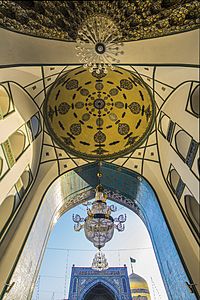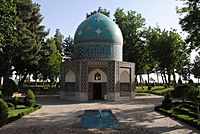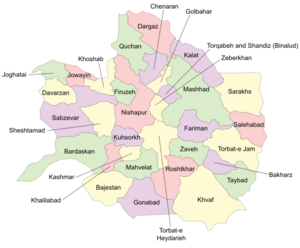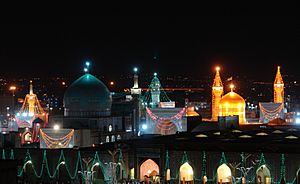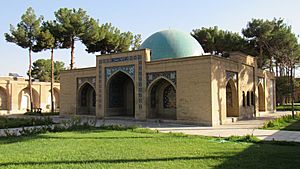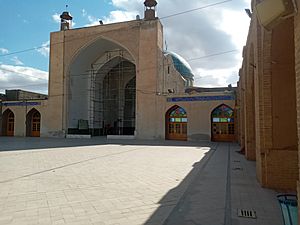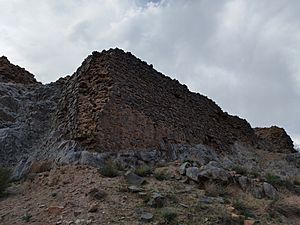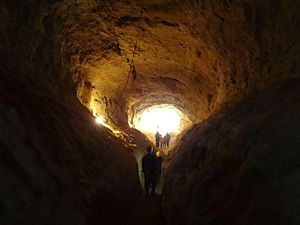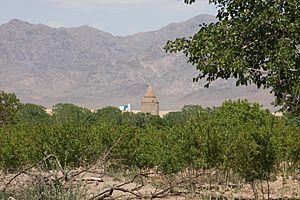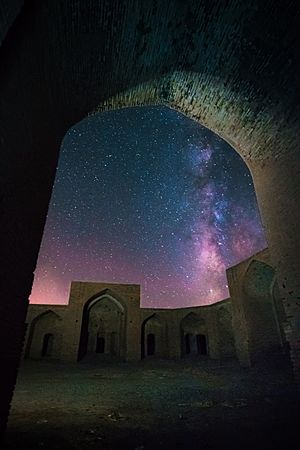Razavi Khorasan province facts for kids
Quick facts for kids
Razavi Khorasan Province
استان خراسان رضوی
|
|
|---|---|

Location of Khorasan-e Razavi province in Iran
|
|
| Country | Iran |
| Region | Region 5 |
| Capital | Mashhad |
| Counties | 33 |
| Area | |
| • Total | 118,884 km2 (45,901 sq mi) |
| Highest elevation
(Mount Binalud)
|
3,211 m (10,535 ft) |
| Lowest elevation
(Sarakhs)
|
299 m (981 ft) |
| Population | |
| • Total | 6,434,501 |
| • Estimate
(2020)
|
6,871,000 |
| • Density | 54.12420/km2 (140.1810/sq mi) |
| Demonym(s) | Khorasani (Persian: خراسانی) |
| Time zone | UTC+03:30 (IRST) |
| Area code(s) | 051 |
| Main language(s) | Persian |
| HDI (2017) | 0.781 high · 19th |
| Website | http://ostandari.khorasan.ir/ |
Razavi Khorasan Province (Persian: استان خراسان رضوی, Ostân-e Xorâsân-e Razavi) is one of the 31 provinces of Iran. It is located in the northeastern part of Iran. The city of Mashhad is the main city and capital of the province. Razavi Khorasan was formed in 2004 when the larger Khorasan province was divided into three new provinces. In 2014, it became part of Region 5, with Mashhad serving as the main office for the region.
In 2016, the province had a population of about 6.4 million people.
Contents
History of Khorasan
The area known as Greater Khorasan has seen many different ruling families and governments throughout history. Various groups like Arabs, Turks, Kurds, Turkmens, and Mongols have lived here and changed the region over time.
Long ago, Iranian geographers divided Iran into eight main areas. The largest and most successful of these was the territory of Greater Khorasan. Cities like Esfarayen were important places for the Aryan tribes when they first came to Iran.
The Parthian Empire was based near Merv in Khorasan for many years. Later, during the Sassanid dynasty, a military leader called a "Padgošban" governed the province. There were also four other leaders, each in charge of one of the four parts of the province.
When the Muslim conquest of Persia happened, Khorasan was divided into four sections. Each section was named after one of its four largest cities: Nishapur, Merv, Herat, and Balkh.
In the year 651, the army of the Rashidun Caliphate took control of Khorasan. The area was ruled by the Abbasid Caliphate until 820. After that, Iranian ruling families like the Tahirid dynasty (until 873) and the Samanid dynasty (in 900) took over.
Mahmud of Ghazni conquered Khorasan in 994, and then Tuğrul in 1037.
In 1507, Uzbek tribes took over Khorasan. After the death of Nader Shah in 1747, the Afghan Durrani Empire from Qandahar occupied it.
In 1824, Herat became independent for a few years. The Persians tried to take the city in 1837, but the British helped the Afghans stop them. In 1856, the Persians tried again and briefly took the city. This led to the Anglo-Persian War. In 1857, the fighting ended with the Treaty of Paris, and Persian troops left Herat. Afghanistan took back Herat in 1863.
Khorasan was Iran's largest province until it was divided into three smaller provinces on September 29, 2004. The new provinces were Razavi Khorasan, North Khorasan, and South Khorasan.
Archaeological Sites
Archaeological sites are places where people find old objects and buildings from the past. Here are some important ones found in Razavi Khorasan:
Kohandezh Hills
Between 1935 and 1940, an American team dug up many valuable items in Nishapur. These items were so important that some were given to the government, and others are now in the Metropolitan Museum of Art. For many years after 1945, people illegally dug at the site of Nishapur to find old Islamic art. Today, the Kohandezh hills still show signs of these past excavations.
Shadiyakh
Shadiyakh was a significant palace in old Nishapur. It became more important and populated after the 7th century. Sadly, the palace was completely destroyed in the 13th century. Famous people like Farid al-Din Attar, a well-known poet, lived here. His tomb can be found in Shadiyakh.
Administrative Divisions
Razavi Khorasan Province is divided into many smaller areas called counties. The capital city is Mashhad.
Most of the people in Razavi Khorasan province live in cities. Here are some of the biggest cities in the province:

Mashhad Nishapur |
Rank | City | County | Population | 
Sabzevar Torbat-e Heydarieh |
|---|---|---|---|---|---|
| 1 | Mashhad | Mashhad | 2,987,323 | ||
| 2 | Nishapur | Nishapur | 264,375 | ||
| 3 | Sabzevar | Sabzevar | 243,700 | ||
| 4 | Torbat-e Heydarieh | Torbat-e Heydarieh | 140,019 | ||
| 5 | Kashmar | Kashmar | 102,282 | ||
| 6 | Quchan | Quchan | 101,604 | ||
| 7 | Torbat-e Jam | Torbat-e Jam | 100,449 | ||
| 8 | Taybad | Taybad | 56,562 | ||
| 9 | Chenaran | Chenaran | 53,879 | ||
| 10 | Sarakhs | Sarakhs | 42,179 |
Culture and Attractions
Razavi Khorasan Province has many interesting historical places and beautiful natural spots. You can find mineral water springs, small lakes, fun recreation areas, caves, and places for hiking.
The province is also home to many important religious buildings and pilgrimage sites. These include the Imam Reza shrine, the Goharshad mosque, and many other tombs and holy places that attract visitors.
Iran's Cultural Heritage organization lists 1179 sites of historical and cultural importance across all three Khorasan provinces.
Here are some popular attractions in Razavi Khorasan:

Mashhad Attractions
- Imam Reza Shrine: A very important religious site.
- Goharshad Mosque: A beautiful mosque.
- Tomb of Nader Shah: The tomb of a famous Iranian ruler.
- Tomb of Khajeh Rabie: A historical tomb.
- Tomb of Ferdowsi: The resting place of a famous Persian poet.
- Haruniyeh Dome: An ancient building.

Nishapur Attractions
- Mausoleum of Attar of Nishapur: The tomb of a famous poet and mystic.
- Mausoleum of Omar Khayyám: The tomb of a well-known poet, mathematician, and astronomer.
- Tomb of Kamal-ol-molk: The tomb of a famous painter.
- Tomb of Heydar Yaghma: A historical tomb.
- Shadiyakh: An important historical palace site.
- Jameh Mosque of Nishapur: A large mosque.
Sabzevar Attractions
- Khosrogerd Minaret: A tall, old tower.
- Pamenar Mosque, Sabzevar: A historical mosque.
- Jameh Mosque of Sabzevar: A large mosque.
- Tomb of Hadi Sabzevari: The tomb of a philosopher.
- Tomb of Boghrat: A historical tomb.
Kashmar Attractions
- Arg of Kashmar: An ancient fortress.
- Tomb of Hassan Modarres: A historical tomb.
- Imamzadeh Seyed Morteza: A religious shrine.
- Imamzadeh Hamzeh, Kashmar: A religious shrine.
- Imamzadeh Mohammad: A religious shrine.
- Grave of Pir Quzhd: A historical grave.
- Jameh Mosque of Kashmar: A large mosque.
- Haj Soltan Religious School: An old religious school.
- Haji Jalal Mosque: A historical mosque.
- Atashgah Manmade-Cave: A cave made by people.
- Atashgah Castle: An ancient castle.
- Kohneh Castle, Zendeh Jan: An old castle.
- Rig Castle: A historical castle.
- Amin al-tojar Caravansarai: An old roadside inn for travelers.
- Talaabad Watermill: An old watermill.
- Yakhchāl of Kashmar: An ancient ice house.
Khalilabad Attractions
- Jameh Mosque of Khalilabad: A large mosque.
- Kondor castle: An old castle.
- Kondor Ab anbars: Old water reservoirs.
Torbat-e Jam Attractions
- Sheikh Ahmad-e Jami mausoleum complex: A group of buildings around a tomb.
Gonabad Attractions
- Forud castle: An ancient castle.
- Qanats of Gonabad: Very old underground water channels.
- Kūh-Zibad: A mountain.
Sarakhs Attractions
- Ribat-i Sharaf: An old caravanserai (inn).
- Tomb of Baba Loghman: A historical tomb.
Bardaskan Attractions
- Tomb of Abdolabad: A historical tomb.
- Aliabad Tower: An old tower.
- Firuzabad Tower: An old tower.
- Firuzabad area: A historical area.
- Seyyed Bagher Ab anbar: An old water reservoir.
- Darone Cave: A natural cave.
- Sir Cave: A natural cave.
- Rahmanniyeh Castle: An ancient castle.
- Qal'eh Dokhtar, Khooshab: An old castle.
- Qal'eh Dokhtar, Doruneh: An old castle.
Bajestan Attractions
- Jameh Mosque of Marandiz: A large mosque.
Taybad Attractions
- Abbasabad Complex Taybad: A historical complex.
- Karat Minaret: A tall, old tower.
Rivash Attractions
- Qal'eh Dokhtar, Kuhsorkh: An old castle.
- Nameq Village: A historical village.
- Shahi Dam: A dam.
- Gabar Hesar castle: An ancient castle.
- Baghdasht Peak: A mountain peak.
- Band-e Qara Bathhouse: An old bathhouse.
- Natural Yakhchāl of Band-e Qara: A natural ice house.
Images for kids
See also
 In Spanish: Provincia de Jorasán Razaví para niños
In Spanish: Provincia de Jorasán Razaví para niños


